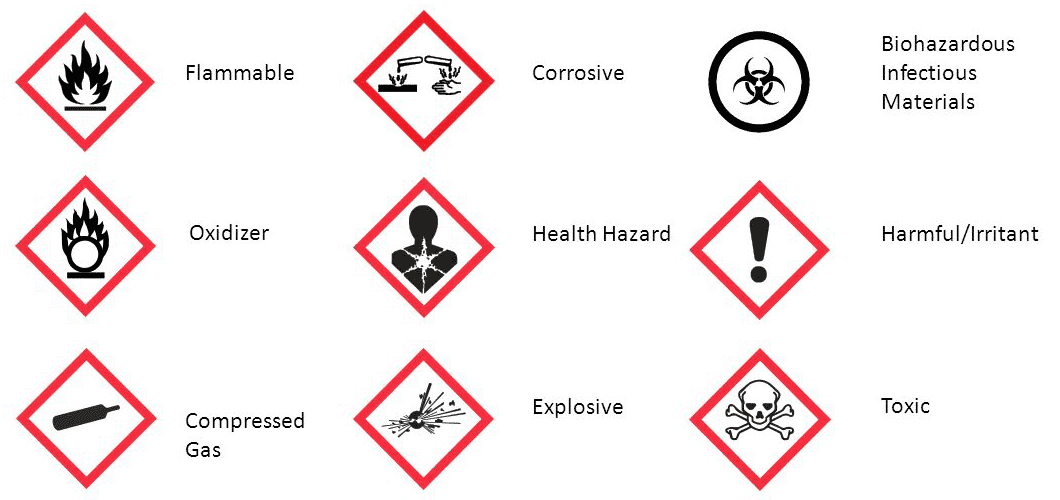SAFETY FIRST
Workplace safety is a crucial consideration for any field of work. This unit will cover important safety information – specifically in the workplace – to ensure that you are aware and prepared for potential danger.
The Workplace Hazardous Materials Information System (WHMIS), is Canada’s national workplace hazard communication standard. The key elements of the system are:
- cautionary labelling of containers of WHMIS controlled products
- the provision of safety data sheets (SDSs)
- worker education and site-specific training programs
Workplace Chemicals and Safety
WHMIS – Roles and Responsibilities
According to WHMIS the roles and responsibilities of suppliers, employers, and workers are as follows:
Suppliers must:
- Classify hazardous products
- Prepare and provide labels and MSDSs or SDSs to customers
- Provide supplier labels on all containers of hazardous products they sell or produce
Employers must:
- Ensure that all hazardous products are properly labelled
- Make SDSs readily available to workers
- Prepare workplace labels and SDSs as necessary
- Provide worker education and training
Workers must:
- Participate in WHMIS training programs
- Take necessary steps to protect themselves and their co-workers
- Participate in identifying and controlling hazards
- Inform employers if labels are illegible or missing resources
Safety Data Sheets (SDS)
A Safety Data Sheet (SDS) is a document that contains information on the potential hazards (health, fire, reactivity and environmental) and how to work safely with the chemical product. It is an essential starting point for the development of a complete health and safety program. It also contains information on the use, storage, handling and emergency procedures all related to the hazards of the material. The SDS contains much more information about the material than the label. SDSs are prepared by the supplier or manufacturer of the material. It is intended to tell what the hazards of the product are, how to use the product safely, what to expect if the recommendations are not followed, what to do if accidents occur, how to recognize symptoms of overexposure, and what to do if such incidents occur.
In Canada, every material that is controlled by WHMIS (Workplace Hazardous Materials Information System) must have an accompanying SDS that is specific to each individual product or material (both the product name and supplier on the SDS must match the material in use).
This video highlights the ten things you should know right away before using any chemical product in the workplace, but it goes double for home safety. Even simple household products can contain potentially hazardous chemicals. Use the Safety Data Sheets (SDS) to find information necessary to protect yourself, your co-workers and your family. Always follow all label warnings, cautions and instructions.
WHMIS Symbols
All containers in the chemical storage area in your science classroom, if you are in a school, have Workplace Hazardous Materials Information System (WHMIS) symbols. This system is used across Canada in every workplace that uses chemicals. Each chemical comes with a Safety Data Sheet (SDS) that gives all the known data on its toxic effects and other hazards.
Look at the following WHMIS symbols. Make sure you can recall the symbol with its meaning.

Young Workers Rights
Across Canada there are laws in place to protect workers – including young and new workers – on the job. This legislation gives three important rights to all workers to ensure that they have the knowledge they need to be safe on the job and the freedom to participate in health and safety activities in their workplace. These rights include: the right to know; the right to participate; and the right to refuse unsafe work.
Young Workers Safety
As you begin working part-time or at summer jobs, you will encounter products – some which have obvious hazards and others where the hazard and risk is less obvious. Learn the hazards and risks before you begin!
SDSs and Labels: READ product labels and the SDS before you work with a product.
ASK about hazards in your workplace such as:
- What are the hazards or dangers of my job?
- Are there any specific rules for health and safety?
- Have there been any accidents or near-accidents in the past in my work area? Why?
- How can they be prevented?
REPORT
- missing or unreadable SDS or labels to your supervisor.
- any unsafe working conditions or faulty equipment
- any injury or accident to your supervisor immediately
EXPECT WHMIS education and training if you work with hazardous products.
UNDERSTAND why you are given Personal Protective Equipment (PPE) and how to use it.
FIND OUT who to ask if you have questions and need more detailed health and safety information.
WASH your hands well after using any chemicals.
KNOW your emergency procedures and where emergency equipment is located.
LEARN who to go to if you are injured on the job. REPORT any injury or accident to your supervisor immediately.
NEVER EAT or DRINK near hazardous products.
What’s Wrong with this Photo?
‘Click here’to test yourself by spotting workplace hazards in landscaping, restaurants, warehouses and kitchens
